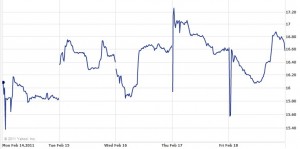Last week didn’t inspire a lot of confidence in the CBOE’s Volatility index: VIX
- A 0.6% SPX dip, gone two hours later triggers a 3.75% step up in the VIX that didn’t go away
- At the Thursday morning opening VIX glitches down 0.6 points and then jumps 1.3 points
- VIX glitches down a point Friday morning for 15 minutes, and then recovers to within 0.03 points of where it was

.
.
.
.
.
.
Do these gyrations indicate something about the market, or more likely is the VIX index being jerked around by unusual SPX option trading? For the last two movements I suspect the latter. I’ve wondered if the SPX option market has been losing favor to other competitors (e.g., SPY or futures options). Overall option volume on SPY looks to be about 10x higher than SPX, and the spreads are tighter, but CBOE’s data shows good growth in the SPX options.
On top of VIX’s glitchiness we have the typical Friday drop due to the weekend effect and the compensating Monday bounce. All together we have an index that is sure to confuse the average investor. If I was designing a competitive index, I would use SPY options instead of SPX, introduce a smoothing algorithm to dampen quick IV moves that aren’t reflected across most strikes, and add a non-trading day correction factor to at least partially null out the weekend/holiday effects. With those changes I think you would end up with a index that better reflects true implied volatility.
.

I suppose people might be rolling large positions ahead of options expiration. If there is a similar pattern every month that would be strong support for your hypothesis. Even if option expiration is the reason I still think the VIX calculation should be more robust, so that it doesn’t get drug around by some anomalous trades.
— Vance
Don’t you think the ‘glitches’ are a result of Feb OPEX?